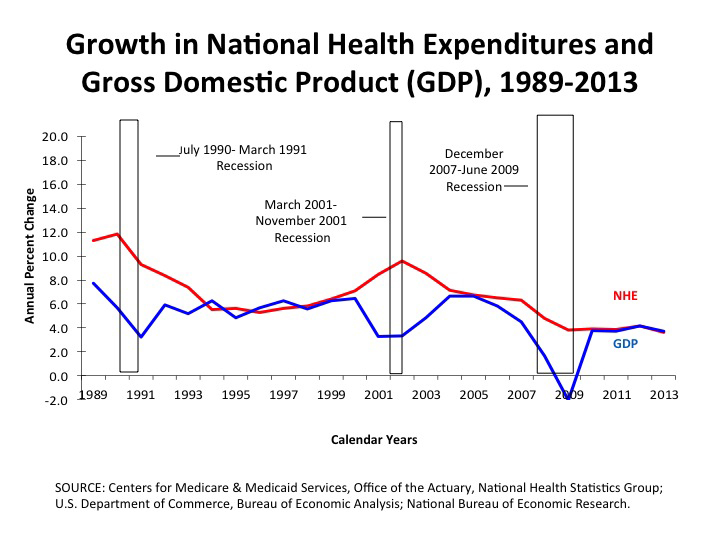Total spending on healthcare in the United States grew at the lowest rate in over 50 years in 2013, according to data released on Wednesday by federal actuaries, as cost-saving changes to Medicare and private insurance combined with the lingering effects of the economic downturn.
The data, put out by actuaries from the Centers for Medicare and Medicaid Services and published by the journal Health Affairs, does not reflect the large expansion of insurance coverage from President Obama’s healthcare law that occurred in 2014, which is expected to spike spending for this year.
Rising healthcare spending has long been seen as the biggest threat to the nation’s long-term fiscal health, particularly as an aging population demands more medical services. And indeed, in 2013, overall health spending reached $2.9 trillion, gobbling up 17.4 percent of the nation’s economic output.
But since 2009, healthcare spending has been growing at historically low levels annually, never hitting above 4.1 percent. The 3.6 percent growth in 2013 was the lowest ever recorded since CMS started tracking numbers in 1960, according to Micah Hartman, a statistician in the Office of the Actuary. Annual healthcare spending grew at an average rate of 7.2 percent over the 1990 to 2008 time frame.
The slowdown in health costs in recent years has triggered a fierce debate within the healthcare policy community. Some argue the trend can be explained mainly by the sluggish economy, in which Americans, especially those who lost their jobs and their insurance, cut back on medical spending, while others have suggested the slowdown might be attributable to more permanent trends in the healthcare sector.
If the spending growth slowdown does turn out to be a longer-term trend, it would significantly brighten the nation’s fiscal outlook, reshuffling the debate about the magnitude of change needed to put the nation’s entitlements on a stable financial footing.
For now, CMS actuaries are remaining cautious about drawing such a conclusion. In 2013, the authors of the report note, health spending grew at the same pace as the overall economy, which is consistent with historical experience. “Growth in health spending and GDP have tended to converge several years after the end of economic recessions,” they wrote.

The actuaries, both in the report and at an event at the National Press Club, highlighted several specific reasons why the growth in spending was slower in 2013 than in 2012, when it was 4.1 percent.
Part of the change was attributed to the slowdown in Medicare spending due to lower enrollment growth in 2013, and cuts put in place by Obamacare and triggered by federal budget sequestration, which were offset somewhat by an acceleration in Medicaid spending. Prescription drug spending grew at a relatively modest 2.5 percent rate, but this was still up from 2012, when spending grew at just 0.5 percent as many blockbuster drugs lost patent protection and went generic.
Spending on private insurance also grew at a slower rate, CMS actuaries said, in part because of the embrace of high-deductible health plans, which offer lower monthly premiums and tend to make consumers more conscious of unnecessary health spending, because they have to cover expenses out of their own pockets until the deductible kicks in. Actuaries also said that Obamacare’s measures to have regulators review rates — as well as the cap placed on insurers’ profits and administrative costs known as the medical loss ratio — helped keep spending down.
The actuaries said there were parts of Obamacare that lowered spending in 2013 as well as other provisions that put upward pressure on spending. On one hand, the law saved money by reducing Medicare payment rates and instituting reforms to the private insurance market. On the other hand, the law boosted Medicaid payments, increased subsidies for Medicare’s prescription drug program, and raised taxes on the drug industry. Actuaries were not able to isolate the net effect of the legislation on spending.
But 2013 data offer only a limited view of Obamacare’s effect on spending anyway, because it did not reflect the implementation of the major spending provisions.
In 2014, Obamacare added millions of individuals to Medicaid and expanded private insurance through its subsidized exchanges. In September, CMS actuaries projected that healthcare spending would spike 5.6 percent during the year. As the economy improves, Obamacare continues to expand, and the Medicare age population explodes, health spending is expected to rise by an average of 6 percent a year over the 2015 to 2023 time period. By 2023, health spending as a percentage of GDP is projected to rise to 19.3 percent — representing nearly one in five dollars of the economy.

